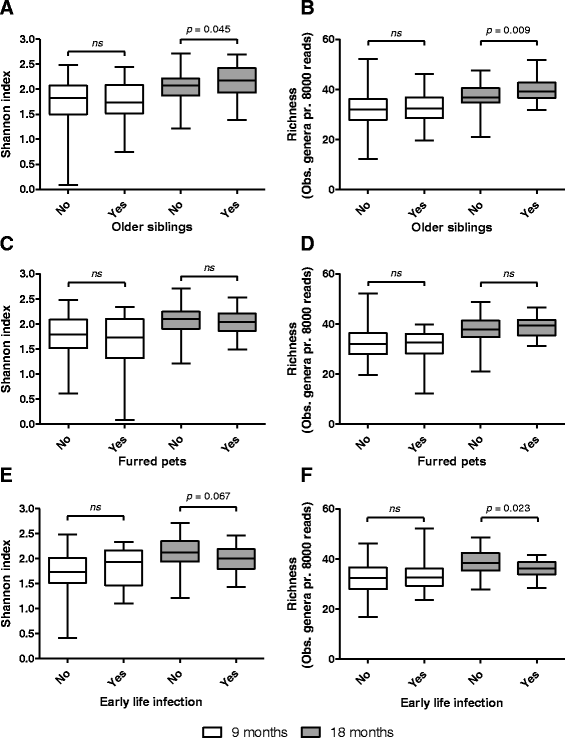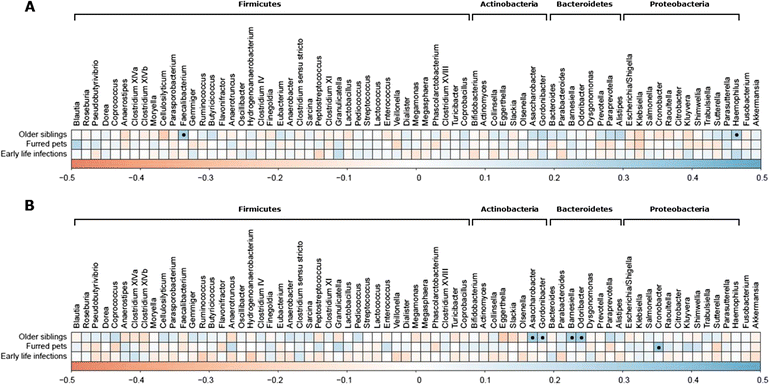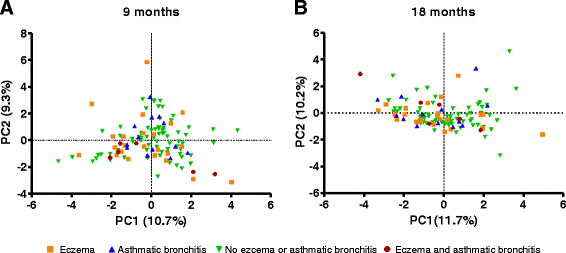Having older siblings is associated with gut microbiota development during early childhood
- PMID: 26231752
- PMCID: PMC4522135
- DOI: 10.1186/s12866-015-0477-6
Having older siblings is associated with gut microbiota development during early childhood
Abstract
Background: Evidence suggests that early life infections, presence of older siblings and furred pets in the household affect the risk of developing allergic diseases through altered microbial exposure. Recently, low gut microbial diversity during infancy has also been linked with later development of allergies. We investigated whether presence of older siblings, furred pets and early life infections affected gut microbial communities at 9 and 18 months of age and whether these differences were associated with the cumulative prevalence of atopic symptoms of eczema and asthmatic bronchitis at 3 years of age. Bacterial compositions and diversity indices were determined in fecal samples collected from 114 infants in the SKOT I cohort at age 9 and 18 months by 16S rRNA gene sequencing. These were compared to the presence of older siblings, furred pets and early life infections and the cumulative prevalence of diagnosed asthmatic bronchitis and self-reported eczema at 3 years of age.
Results: The number of older siblings correlated positively with bacterial diversity (p = 0.030), diversity of the phyla Firmicutes (p = 0.013) and Bacteroidetes (p = 0.004) and bacterial richness (p = 0.006) at 18 months. Further, having older siblings was associated with increased relative abundance of several bacterial taxa at both 9 and 18 months of age. Compared to the effect of having siblings, presence of household furred pets and early life infections had less pronounced effects on the gut microbiota. Gut microbiota characteristics were not significantly associated with cumulative occurrence of eczema and asthmatic bronchitis during the first 3 years of life.
Conclusions: Presence of older siblings is associated with increased gut microbial diversity and richness during early childhood, which could contribute to the substantiation of the hygiene hypothesis. However, no associations were found between gut microbiota and atopic symptoms of eczema and asthmatic bronchitis during early childhood and thus further studies are required to elucidate whether sibling-associated gut microbial changes influence development of allergies later in childhood.
Figures




Similar articles
-
Low gut microbiota diversity in early infancy precedes asthma at school age.Clin Exp Allergy. 2014 Jun;44(6):842-50. doi: 10.1111/cea.12253. Clin Exp Allergy. 2014. PMID: 24330256
-
Low diversity of the gut microbiota in infants with atopic eczema.J Allergy Clin Immunol. 2012 Feb;129(2):434-40, 440.e1-2. doi: 10.1016/j.jaci.2011.10.025. Epub 2011 Dec 6. J Allergy Clin Immunol. 2012. PMID: 22153774 Clinical Trial.
-
Development of the Microbiota and Associations With Birth Mode, Diet, and Atopic Disorders in a Longitudinal Analysis of Stool Samples, Collected From Infancy Through Early Childhood.Gastroenterology. 2020 May;158(6):1584-1596. doi: 10.1053/j.gastro.2020.01.024. Epub 2020 Jan 18. Gastroenterology. 2020. PMID: 31958431
-
The role of skin and gut microbiota in the development of atopic eczema.Br J Dermatol. 2016 Oct;175 Suppl 2:13-18. doi: 10.1111/bjd.14907. Br J Dermatol. 2016. PMID: 27667310 Review.
-
Gut microbiota correlates with energy gain from dietary fibre and appears to be associated with acute and chronic intestinal diseases.Clin Microbiol Infect. 2012 Jul;18 Suppl 4:62-6. doi: 10.1111/j.1469-0691.2012.03859.x. Clin Microbiol Infect. 2012. PMID: 22647053 Review.
Cited by
-
The Effects of Urbanization on the Infant Gut Microbiota and Health Outcomes.Front Pediatr. 2020 Jul 29;8:408. doi: 10.3389/fped.2020.00408. eCollection 2020. Front Pediatr. 2020. PMID: 32903831 Free PMC article. Review.
-
Early-life exposure to per- and polyfluoroalkyl substances and infant gut microbial composition.Environ Epidemiol. 2022 Dec 14;7(1):e238. doi: 10.1097/EE9.0000000000000238. eCollection 2023 Feb. Environ Epidemiol. 2022. PMID: 36777525 Free PMC article.
-
Birth Mode, Breastfeeding, Pet Exposure, and Antibiotic Use: Associations With the Gut Microbiome and Sensitization in Children.Curr Allergy Asthma Rep. 2019 Mar 11;19(4):22. doi: 10.1007/s11882-019-0851-9. Curr Allergy Asthma Rep. 2019. PMID: 30859338 Free PMC article. Review.
-
Development of the Gut Microbiome in Children, and Lifetime Implications for Obesity and Cardiometabolic Disease.Children (Basel). 2018 Nov 27;5(12):160. doi: 10.3390/children5120160. Children (Basel). 2018. PMID: 30486462 Free PMC article. Review.
-
Rurality and relative poverty drive acquisition of a stable and diverse gut microbiome in early childhood in a non-industrialized setting.Res Sq [Preprint]. 2024 Dec 2:rs.3.rs-5361957. doi: 10.21203/rs.3.rs-5361957/v1. Res Sq. 2024. Update in: Sci Rep. 2025 Feb 15;15(1):5601. doi: 10.1038/s41598-025-89224-5. PMID: 39678332 Free PMC article. Updated. Preprint.
References
Publication types
MeSH terms
Substances
LinkOut - more resources
Full Text Sources
Other Literature Sources
Medical

